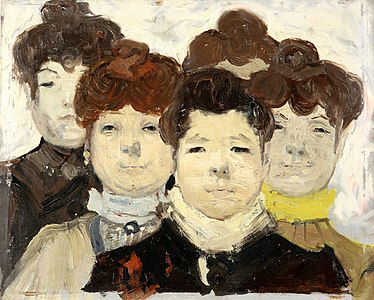Apcar Baltazar
Apcar Baltazar | |
|---|---|
 Baltazarc. 1900 | |
| Born | 26 February 1880 |
| Died | 26 September 1909(aged 29) Bucharest,Kingdom of Romania |
| Education | |
| Known for | painter,art critic,essayist, illustrator,muralist,ceramist |
| Movement | Realism,Post-Impressionism,Expressionism,Symbolism,Art Nouveau |
Apcar Baltazar(26 February 1880,Bucharest– 26 September 1909, Bucharest) was a Romanian painter and art critic of Armenian parentage. His first name is often spelledAbgar,due to differing transliterations from Armenian.
Biography
[edit]He was born into a family of shopkeepers. From 1891 to 1896, he attended the "Cantemir Vodă"Gymnasium,where he received high grades in his drawing classes.

After winning a scholarship competition at the "National School of Fine Arts" (now known as theBucharest National University of Arts), he studied withGeorge Demetrescu Mirea[1]and graduated in 1901. He also made the acquaintance of art historianAlexandru Tzigara-Samurcaș,who introduced him to Romanian folk art.[2]Over the next year, he applied twice at the "Ministry of Religion and Public Instruction" for a scholarship to study abroad, but was denied both times.
In 1903, he had his first showing at an exhibition held by "Tinerimea artistică" (Artistic Youth).[1]That same year saw the beginning of a journal calledVoința națională(The National Will) where his friendsIlarie ChendiandEmil Gârleanugave him critical exposure. He also worked as a clerk for a year at the above-mentioned Ministry before tendering his resignation. From 1904 to 1905, he became a contributor to his friends' journal.
In 1907, he had his first solo exhibition at theSala Ateneului.[1]He also began working as a regular columnist for the magazineViața Românească,where he wrote about the art industry, art education, trends in style and other topics. He also wrote articles for the journalConvorbiri Literare(Literary Talk).[2]Later that year, he entered a contest for a position in the decorative arts department at the School of Fine Arts, but his works were stolen the day before judging and he had to withdraw.
In 1909, his former employers at the Ministry of Religion sent him toHorezu Monasteryto study the condition of its art works and write a report for the "Bulletin of the Historical Monuments Commission". He was preparing to do further studies on other historical monuments and travel to Paris to research methods of restoration, but died of an unspecified heart ailment.
A major retrospective of his work was held at theNational Museum of Art of Romaniato celebrate his birth centennial in 1980.
Selected paintings
[edit]-
Peasants
-
Women ofHaimanale
-
The Death of Lumânărică,from a story byConstantin Negruzzi
References
[edit]- ^abcBrief biography and appreciation@ Ararat Online.
- ^abBrief biography@ Biblioteca Academiei Române.
Further reading
[edit]- Petru Comarnescu,Apcar Baltazar,Editura de stat pentru literatură şi artă, 1956
- Radu Ionescu, ed.,Apcar Baltazar: Convorbiri Artistice(an anthology of his writings), Editura Meridiane, 1974
- Dana Herbay and Dorana Coșoveanu,Apcar Baltazar, 1880–1909: expoziție retrospectivă(exhibition catalog) Muzeul de Artă al Republicii Socialiste România, 1981
External links
[edit]- Apcar Baltazar's biographyArchived26 November 2021 at theWayback Machine
- Gheorghe Samoilă blogan appreciation of his work, with material byKrikor Zambaccian.



